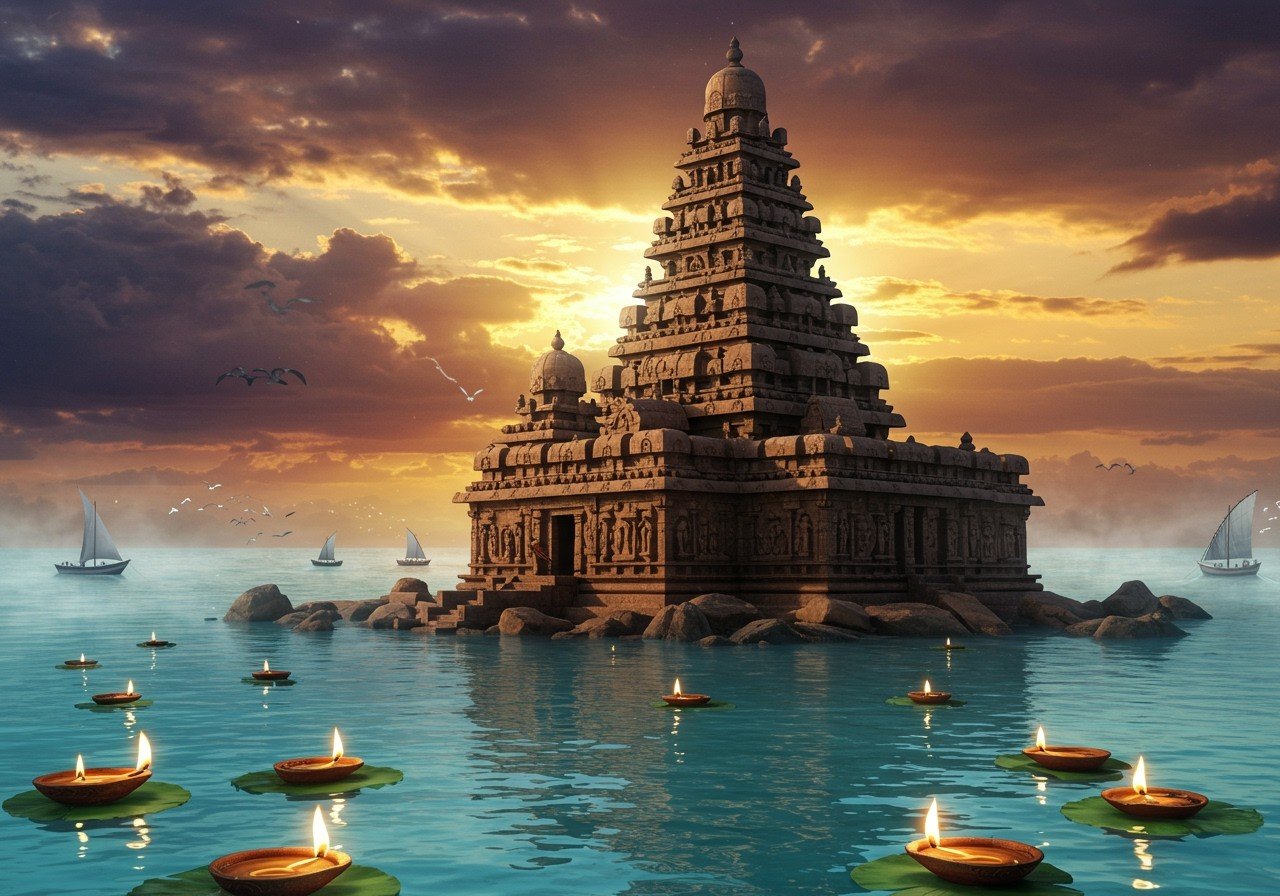
Embark on a captivating exploration of ocean temples, ancient structures that evoke wonder and hold deep cultural meaning. These underwater sanctuaries, steeped in history and spiritual essence, beckon us to unravel their mysteries. They resonate particularly with culturally rooted Indians who value tradition and appreciate the convenience of online shopping for authentic ritual items, like those available at poojn.in.
The Mystical Aura of Ocean Temples
Ocean temples embody a unique spiritual ambiance. Often located near water bodies, they symbolize the transition between the earthly and divine realms, enhancing their mystical charm. Their architectural brilliance and intricate craftsmanship showcase the devotion and artistic expression of ancient cultures. These sacred sites serve as a spiritual beacon for pilgrims and tourists alike.
Need puja samagri for your next temple visit? Poojn.in offers a wide selection of authentic items delivered right to your doorstep.
Temples Amidst the Waves
The history of temples built in the heart of the ocean is truly captivating. Take, for instance, the Tanah Lot Temple in Indonesia. Renowned for its breathtaking ocean vistas, it holds profound spiritual significance in Balinese Hinduism. Perched on a rocky outcrop, it is believed to be under the protection of marine guardian spirits, bestowing prosperity and safety. This temple plays a vital role in local cultural festivals and attracts visitors seeking both spiritual solace and scenic beauty.
Japanese Temples and the Sea
Japan’s underwater temples epitomize the reverence for nature and the intertwining of Shinto beliefs with natural elements. These submerged shrines, possibly erected to honor sea deities and ensure safe passage for seafarers, hold historical significance. Notable examples include the Itsukushima Shrine, with its iconic torii gate that seems to float on the water during high tide. These sites exemplify the harmonious relationship between humanity and nature deeply embedded in Japanese culture.
Tanah Lot Temple: A Cultural and Spiritual Icon
Tanah Lot Temple stands as a prominent cultural and spiritual landmark in Balinese Hinduism. Believed to have been established in the 16th century by the Hindu priest Dang Hyang Nirartha, it plays a crucial role in religious ceremonies and embodies spiritual harmony with nature. Its architectural features, such as the multi-tiered shrines seamlessly integrated with the seascape, further enhance its cultural importance.
Preserving Our Ocean Heritage
Preserving ocean temples presents unique challenges due to natural erosion, climate change, and human activity. Ongoing conservation efforts strive to safeguard these cultural treasures for future generations. Successful initiatives, like the restoration work at Tanah Lot, which focused on stabilizing the rock foundation to prevent collapse, demonstrate the commitment to protecting these sacred sites. Maintaining a delicate balance between tourism and conservation is essential to ensure the longevity of these temples.
Underwater Temples and Submerged Structures Around the World
- Mahabalipuram, India: The submerged shore temples of Mahabalipuram, estimated to be between 1,100 and 1,500 years old, stand as remnants of an ancient port. While their general structure remains intact, they bear the marks of water erosion and algae growth. It is believed that rising sea levels and a possible tsunami-like event in 952 AD contributed to their submersion. These temples continue to fascinate and draw visitors interested in ancient maritime history.
- Lion City of Qiandao Lake, China: Dubbed the “Oriental Atlantis,” Lion City (Shi Cheng) lies 40 meters beneath the surface of Qiandao Lake. Intentionally flooded in 1959 to create a hydroelectric power station, this submerged city features well-preserved white temples, paved roads, and houses, offering a glimpse into a bygone era. Divers can explore this underwater time capsule and witness the remarkable preservation of its structures.
- Underwater Temple Garden in Pemuteran, Bali: This unique site blends art and environmental conservation. Designed to resemble an ancient temple, the structures provide a substrate for coral growth and create a thriving habitat for marine life. Divers can explore this artificial reef and witness the beauty of art intertwined with nature.
- Submerged Stupas of Amed, Bali: Off the coast of Amed, this dive site showcases underwater Buddhist stupa designs. These structures serve as both a meditation space for divers and a habitat for marine creatures, highlighting the connection between spirituality and the natural world. The serene underwater setting provides a unique meditative experience.
- Archaeological Park of Baia, Italy: Near Naples lie the submerged ruins of Baia, a once-thriving Roman resort city. Now underwater, these ruins provide a fascinating glimpse into the past, showcasing the opulence and grandeur of Roman architecture. Divers and snorkelers can explore the remnants of this ancient city.
Poojn.in: Your Companion for Ocean Temple Traditions
Whether you’re planning a visit to an ocean temple or wish to perform related rituals at home, poojn.in offers a wide array of essential puja items and resources. Our authentic collection includes:
- Conch shells (shankh) for traditional water offerings
- Pure copper vessels for abhishekam ceremonies
- Natural incense and dhoop for seaside prayers
- Special oil lamps designed to withstand coastal winds
- Brass and silver items for water deity worship
Looking for a specific item for a water deity? Explore our collection of Adiyogi statues, Lord Shiva murtis, and other deity idols.
We also offer insightful guides about ocean temple deities, such as Lord Vishnu, who rests on the cosmic ocean, and various water-associated forms of Devi. Our knowledgeable team can assist you in selecting the appropriate items for specific ocean temple rituals and customs. For home worship connected to ocean temples, we provide complete puja kits with all the necessary items and easy-to-follow instructions in multiple languages. Gomti Chakras are also a wonderful addition to your puja collection.
Connect with Us
Contact us at 03369029784 or WhatsApp 9476142738 for:
- Personalized puja item selection
- Guidance on rituals
- Bulk orders for temple visits
- Pan-India delivery
- Expert consultation on ocean temple traditions
Visit www.poojn.in to discover our complete range of authentic puja items. We ensure all products adhere to traditional standards while offering the convenience of online shopping and doorstep delivery across India.
Embracing the Timeless Legacy
Ocean temples hold a special place in our hearts, inspiring awe and reverence. These sacred sites, where the divine meets the earthly, symbolize the rich tapestry of human devotion and nature’s beauty. From Indonesia’s Tanah Lot to the submerged wonders of Mahabalipuram and Japan, each temple tells a story of spiritual harmony and cultural heritage. As we admire their architectural grandeur and historical depth, let us also recognize the importance of preserving these treasures for generations to come. By embracing both conservation and appreciation, we ensure that these ocean temples continue to be a source of inspiration and reflection.
Frequently Asked Questions About Ocean Temples
What is an Ocean Temple? An ocean temple is a sacred structure typically built on, near, or even under the sea. These temples often hold deep spiritual significance related to water deities or the power of the ocean and provide a unique and mystical atmosphere for worship and contemplation.
Why are Ocean Temples considered mystical? The unique location of ocean temples, often surrounded by water or submerged beneath the waves, contributes to their mystical aura. The combination of natural beauty, spiritual significance, and sometimes, the mystery of their origins, creates a sense of awe and wonder.
Can you give examples of temples located in the middle of the sea? Certainly! Tanah Lot Temple in Bali, Indonesia is a classic example, situated on a rocky outcrop in the sea. Other examples include the submerged shore temples of Mahabalipuram, India, and the Itsukushima Shrine in Japan, known for its torii gate that appears to float on the water during high tide.
What is the cultural and spiritual significance of Tanah Lot Temple? Tanah Lot Temple holds deep meaning within Balinese Hinduism. It’s dedicated to sea gods and is believed to offer protection from evil spirits. It’s not only a place of worship but also a significant cultural landmark, attracting both pilgrims and tourists who come to witness its beauty and experience its spiritual energy.
Are there Japanese temples associated with the sea? Yes, Japan has a rich tradition of temples connected to the sea, reflecting the importance of the ocean in Japanese culture and spirituality. Itsukushima Shrine is perhaps the most famous, but many other smaller shrines and sacred sites are located along the coast or on islands.
How do Ocean Temples connect with tradition? Ocean temples often serve as focal points for traditional ceremonies and rituals related to the sea, such as offerings to water deities, prayers for safe voyages, and celebrations of the ocean’s bounty. These rituals and traditions have been passed down through generations, connecting present-day worshippers to their ancestors and cultural heritage.
Why do people visit Ocean Temples for spiritual purposes? The serene and naturally beautiful setting of ocean temples can create a conducive environment for spiritual practices like meditation and prayer. The vastness of the ocean can evoke a sense of peace and connection to something larger than oneself, deepening the spiritual experience.
Are there specific rituals performed at Ocean Temples? Yes, many ocean temples have unique rituals and ceremonies connected to the specific deities worshipped there or the local traditions of the area. These might involve offerings of flowers, food, or incense to the sea, chanting prayers, or performing specific rituals to honor the ocean’s power.


